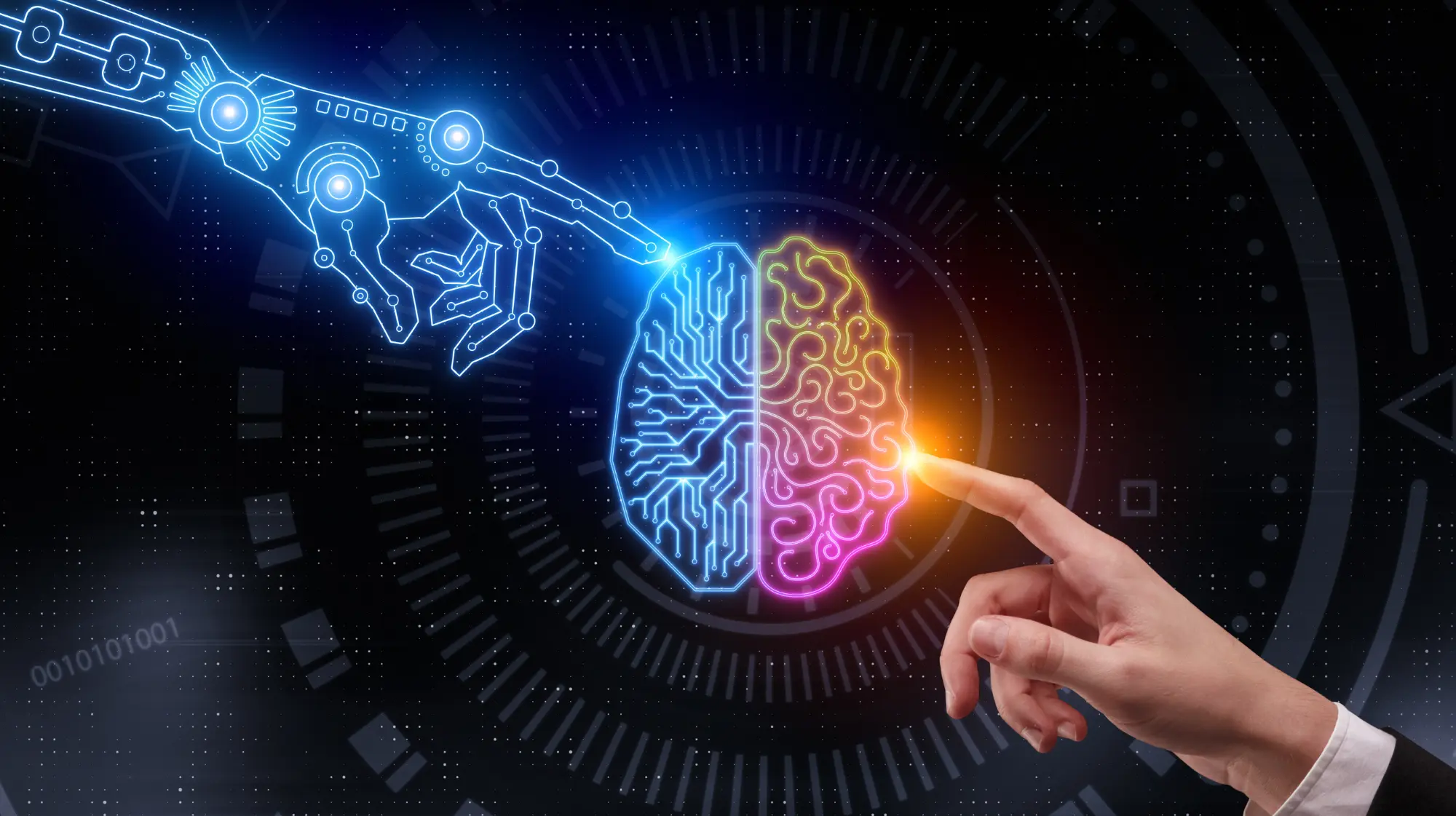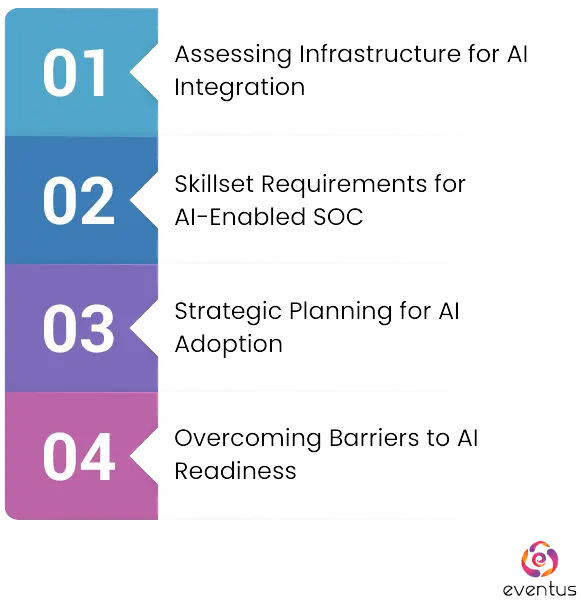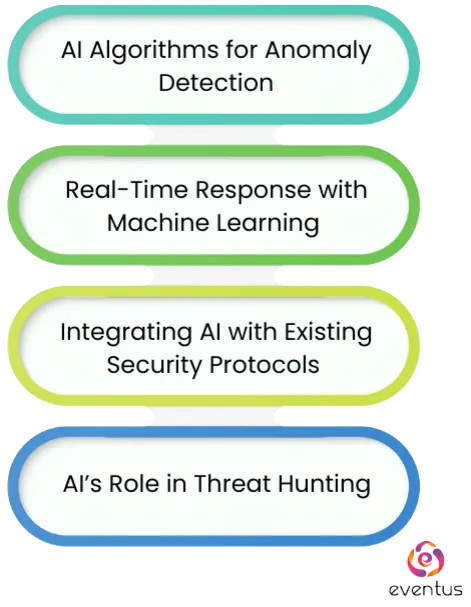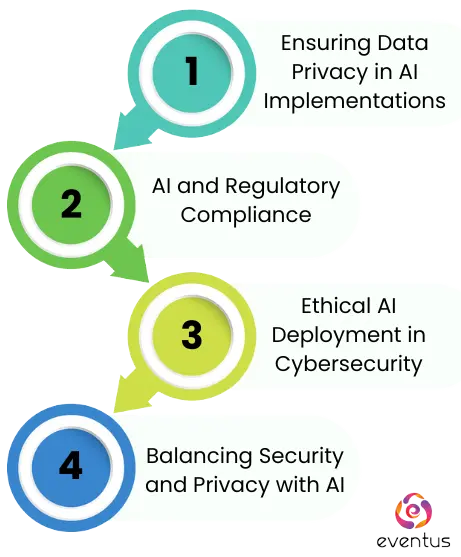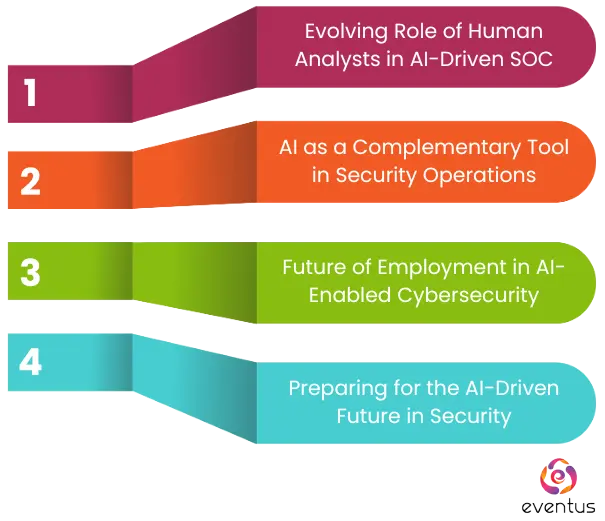The article discusses the significant role of Artificial Intelligence (AI) and Machine Learning (ML) in enhancing information security. It delves into how these technologies transform cybersecurity through enhanced threat intelligence, risk assessment, data analysis, and predictive capabilities. It also explores the advantages and challenges of integrating AI and ML in Security Operations Centers (SOCs), balancing human expertise with AI automation, and the ethical considerations and future trends in AI and ML applications in cybersecurity.
Table of Contents
What is the Role of AI and ML in Information Security?
The role of AI and ML in information security is pivotal and transformative. Through leveraging machine learning algorithms, security systems can analyze vast volumes of data to identify anomalies, enhancing threat intelligence and indicators of compromise. This capability allows for proactive detection and response to cyber threats, moving beyond traditional security measures. AI and ML models are integral in security operations centers (SOCs), providing advanced tools for security teams. They automate and orchestrate security tasks, improving the efficiency and accuracy of security processes. By incorporating deep learning and supervised machine learning techniques, AI and ML strengthen an organization's security posture and help in adapting to the evolving security landscape. Your organization can leverage cutting-edge AI and ML technologies via collaboration with a SOC solution provider. These technologies are becoming indispensable in cybersecurity, offering a more robust, holistic approach to protecting against cyber attacks and improving overall enterprise security.
What are the Advantages and Disadvantages of Using AI in SOC?
The integration of Artificial Intelligence (AI) and Machine Learning (ML) in Security Operations Centers (SOCs) has become a focal point for cybersecurity. Let's delve into the advantages and challenges of this integration.
Increasing Efficiency with AI: The Pros
The incorporation of AI and ML in cybersecurity, particularly in SOCs, significantly boosts efficiency:
- Automated Threat Detection: AI and ML algorithms excel in detecting anomalies and cyber threats, often identifying risks faster than traditional security measures.
- Enhanced Threat Intelligence: These technologies improve threat intelligence by analyzing large volumes of data, offering more accurate predictions and responses to security incidents.
- Reduction in Response Time: AI-driven security tools can rapidly respond to security breaches, improving an organization's security posture.
Potential Risks and Limitations of AI in SOC
However, the use of AI and ML is not without its challenges:
- Dependence on Training Data: The quality of AI models depends on their training data. If this data is incomplete or biased, the models might not detect threats correctly.
- Evolution of Cyber Threats: AI systems might struggle to adapt to new, sophisticated cyber attacks beyond their existing programming and recognition capabilities.
- Security of AI Systems: Ironically, the AI systems can themselves become targets of cyber attacks, potentially compromising the SOC.
Balancing Human Expertise and AI Automation
A balanced approach is essential:
- Complementing Human Analysis: While AI can handle vast amounts of data, human expertise is crucial for nuanced analysis and decision-making in complex security situations.
- AI as a Tool, not a Replacement: Security professionals in a SOC should view AI and ML as tools to augment their skills, not replacements.
Cost Implications of Integrating AI into SOC
Implementing AI in SOCs involves financial considerations:
- Initial Investment: The cost of integrating AI and ML models into existing security systems can be substantial.
- Maintenance and Upgrades: Continuous updates and maintenance of AI systems to keep up with evolving cyber threats also incur costs.
- ROI and Long-Term Benefits: However, the potential long-term benefits, such as improved security and efficiency, can justify the initial investment.
Is Your Organization AI-ready for SOC?
Preparing for AI integration in a Security Operations Center (SOC) involves practical steps and strategic planning. Let's explore realistic methods for assessing readiness, identifying necessary skills, strategic planning, and overcoming common barriers.
Assessing Infrastructure for AI Integration
To effectively integrate AI and ML in cybersecurity, start with a realistic assessment of your current infrastructure:
- Technology Audit: Evaluate your existing hardware and software to determine if they can support AI algorithms and ML models. This process includes checking processor capacities, storage, and network bandwidth.
- Data Quality Assessment: AI and ML depend heavily on quality data. Assess quality, quantity, and variety of security data to ensure it's adequate for training AI models.
- Compatibility Check: Ensure your current security tools and solutions are compatible with AI and ML technologies or need an upgrade.
Skillset Requirements for AI-Enabled SOC
For an AI-enabled SOC, specific skill sets are essential:
- AI/ML Proficiency: Security analysts should have basic knowledge of how AI and ML algorithms work, particularly those used in anomaly detection and threat intelligence.
- Data Science Skills: Familiarity with data processing, cleaning, and analysis is crucial since AI systems rely on well-organized data.
- Continuous Education: Implement regular training programs to keep the team updated with the latest in AI and ML advancements in cybersecurity.
Strategic Planning for AI Adoption
A well-thought-out strategy is critical to successful AI adoption:
- Goal Setting: Define specific, measurable goals such as reducing response time to security incidents or automating routine tasks.
- Implementation Roadmap: Develop a phased approach to AI integration, starting with pilot projects before full-scale implementation.
- Stakeholder Engagement: Involve all stakeholders, from executive leadership to IT staff, ensuring alignment and understanding of the benefits and challenges of AI integration.
Overcoming Barriers to AI Readiness
Common barriers and realistic ways to address them include:
- Budgeting for AI: Allocate resources for initial deployment, ongoing training, and system updates.
- Cultural Adaptation: Foster a culture that embraces technological advancements. Highlight how AI can augment the security team's capabilities rather than replace them.
- Addressing Technical Challenges: Partner with experienced AI vendors to navigate complex technical issues. Regularly review and update security policies to address new AI tech challenges.
How Do You Leverage AI and ML for SOC Innovation and Enhancement?
Leveraging AI (Artificial Intelligence) and ML (Machine Learning) for SOC (Security Operations Center) Innovation and Enhancement involves using these advanced technologies to improve cybersecurity capabilities and responses. Here's how AI and ML can significantly contribute to SOC innovation and enhancement:
Implementing AI for Advanced Threat Detection
Artificial Intelligence (AI) implementation in Security Operations Centers (SOCs) revolutionizes advanced threat detection. AI's ability to rapidly analyze large volumes of data and identify patterns makes it invaluable in detecting cyber threats that traditional security measures may miss. Key aspects include:
- Anomaly detection: AI algorithms excel in spotting unusual activities, signaling potential security breaches.
- Indicators of Compromise (IoCs): AI tools can effectively identify IoCs, enhancing the security posture of organizations.
- Threat intelligence: AI contributes to dynamic and predictive threat intelligence, which is vital for proactive security.
Enhancing Incident Response with ML
Machine Learning (ML) techniques in incident response empower security teams to react more swiftly and effectively. ML's role includes:
- Predictive analysis: Leveraging historical data, ML models can forecast potential security incidents, allowing for preemptive action.
- Automated response: ML can automate some security tasks, reducing the time between detection and response.
- Continuous learning: ML algorithms adapt over time, improving the security system's response capabilities.
AI-Driven Automation in SOC Operations
AI and ML-driven automation actively transforms SOC operations, enhancing efficiency and intelligence. This transformation occurs through:
- Security orchestration: AI integrates various security tools and processes, streamlining operations.
- Real-time analysis: AI systems can process and analyze security data in real time, enhancing the security services provided.
- Efficiency in handling security events: AI can significantly reduce the workload of security analysts, allowing them to focus on more complex tasks.
Continuous Improvement with AI and ML Feedback Loops
The power of AI and ML lies in their ability to continuously learn and evolve, which is essential for the dynamic field of cybersecurity. This continuous improvement is characterized by:
- Adaptive algorithms: ML algorithms and models evolve by learning from new security data, continuously enhancing accuracy.
- Feedback-driven enhancements: AI and ML systems refine their operations based on feedback, leading to more robust security solutions.
- Collaboration with security professionals: AI and ML insights assist security researchers and professionals in creating better security measures.
Threat Detection and Response with AI/ML
AI and ML are revolutionizing threat detection and response in cybersecurity. Their applications in the cybersecurity field are diverse and impactful, offering real-time threat identification and enhanced cyber risk management.
AI Algorithms for Anomaly Detection
Anomaly detection is a critical component in cybersecurity, where AI algorithms play a pivotal role. AI algorithms actively analyze vast amounts of data to identify deviations from established patterns, often signs of cyber threats. AI systems set a baseline for normal network behavior and detect unusual activities that might escape human detection. This capability is crucial for the early identification of potential security breaches, including unknown threats. AI's prowess in anomaly detection comes from its ability to learn and adapt over time, becoming increasingly proficient at spotting even the most subtle irregularities in network traffic, user behavior, or system performance.
Real-Time Response with Machine Learning
Machine Learning (ML) elevates cybersecurity to new heights by enabling real-time response to detected threats. ML algorithms respond instantly to potential threats, unlike traditional systems that might need manual help. This immediacy is crucial in mitigating the impact of cyber attacks. ML systems can automatically initiate actions such as isolating affected networks, blocking suspicious user access, or implementing other security protocols to counter the threat. The real-time aspect of ML ensures a swift response to known threats and adapts to new, evolving risks, making it an indispensable tool in modern cybersecurity arsenals.
Integrating AI with Existing Security Protocols
AI integration with existing security protocols enhances the overall effectiveness of cybersecurity strategies. AI does not replace traditional security measures but complements them. By feeding AI systems with data from existing security tools and protocols, AI algorithms can provide deeper insights and improved decision-making capabilities. This integration allows for a more comprehensive security approach, combining the strengths of AI, such as pattern recognition and predictive analytics, with the robustness of established security protocols. The result is a more fortified defense system capable of anticipating and responding to complex cyber threats with greater precision.
AI’s Role in Threat Hunting
AI is redefining threat hunting in cybersecurity. AI proactively searches for cyber threats that traditional defenses might miss. This proactive approach to cybersecurity involves analyzing data patterns, user behavior, and network anomalies to unearth hidden threats. AI's capability to process and analyze large datasets quickly and efficiently makes it an ideal tool for this task. Through advanced pattern recognition and predictive analytics, AI can uncover subtle signs of compromise that might go unnoticed without it. This proactive stance not only helps in identifying current threats but also aids in predicting and preparing for future vulnerabilities, thereby strengthening an organization's cybersecurity posture.
Proactive Steps to Apply AI to Cybersecurity Without Compromising Privacy
Applying AI to cybersecurity without compromising privacy is a multifaceted challenge that requires a careful balance between technological advancement and ethical considerations. Here are some proactive steps organizations can take:
- Ensuring Data Privacy in AI Implementations: Federated learning involves training local ML models on private datasets and sharing only the model updates while keeping the original data secure in its location. It is an important method for protecting data privacy when training machine learning models, especially in healthcare areas with sensitive user data. This decentralized approach significantly reduces the risk of a privacy breach, as the data isn't aggregated in a single repository but distributed across multiple locations.
- AI and Regulatory Compliance: The landscape of privacy laws is constantly evolving, with new regulations emerging that dictate how consumer data is collected, processed, and shared. Organizations must be vigilant to ensure AI tools comply with these laws, particularly regarding automated decision-making and data sharing. This process involves understanding the tools, the data, the laws involved, and the potential impact on consumers; it can include steps like contract reviews, risk assessments, and developing mechanisms for reviewing and overriding AI decisions.
- Ethical AI Deployment in Cybersecurity: It's crucial to focus on developing AI systems that are not only effective but also ethical and transparent. One area of focus is Explainable AI (XAI), which aims to make AI/ML models more interpretable and accountable. In sectors like healthcare and banking, where decisions have significant impacts, it's necessary to understand the rationale behind AI-driven decisions, especially to avoid biases.
- Balancing Security and Privacy with AI: While AI and ML offer powerful tools for enhancing cybersecurity, they also present privacy challenges. To address these, organizations can adopt AIOps/MLOps, which standardize operations across the AI/ML lifecycle, measure performance, and automate issue remediation. This approach makes identification and mitigation of privacy risks easier while enhancing efficiency and security.
Behavioral Analytics in AI-powered SOC
- Understanding User Behavior with AI: AI-powered Security Operations Centers (SOCs) use behavioral analytics to understand user behavior comprehensively. This process involves collecting a broad range of data, including user activities and network traffic, to establish normal behavior patterns. The AI then uses this data to detect deviations, which might indicate security threats.
- Detecting Insider Threats Using Behavioral Analytics: Behavioral analytics is particularly effective in identifying insider threats. By analyzing user behaviors, AI systems can detect unusual activities that may signify a user misusing their access privileges or a compromised account. This proactive approach aids in the early detection and prevention of internal security breaches.
- Enhancing Security Posture with Behavioral Insights: AI-driven behavioral analytics contribute to strengthening an organization's overall security posture. By continuously learning from user behaviors and system interactions, AI can provide valuable insights into potential vulnerabilities and areas that require enhanced security measures.
- AI in Unusual Activity Detection: AI systems excel in identifying patterns and anomalies in user and network activities. This capability allows them to quickly flag any unusual activity indicating a cyber threat, ranging from minor policy violations to significant security incidents, enhancing the SOC's overall threat detection and response capabilities.
Neural Networks for SOC Applications
- Utilizing Deep Learning in Cyber Threat Analysis: SOCs are increasingly using deep learning, a subset of machine learning, for sophisticated cyber threat analysis. This advanced approach allows for a more effective and nuanced understanding of potential security risks. These neural networks can process vast amounts of security data, learning from past patterns to predict and detect potential threats.
- Neural Networks in Predictive Security Modeling: Neural networks are also instrumental in predictive security modeling. They can look at past data to spot trends and behaviors that could signal possible future attacks, helping organizations enhance their defenses ahead of time.
- Advanced Pattern Recognition with Neural Networks: Neural networks' advanced pattern recognition capabilities allow them to identify complex threat patterns that traditional security tools might miss. This process includes correlating disparate data points to detect sophisticated cyber attacks.
- Customizing Neural Networks for SOC Needs: Neural networks can be customized to meet specific SOC requirements. This process involves training the models on relevant data to ensure they are attuned to the organization's unique security challenges and threat landscape.
Automated Remediation using AI in SOC
- AI in Rapid Incident Containment: AI plays a crucial role in rapid incident containment within SOCs. By automating the incident response process, AI enables immediate action against detected threats, minimizing their impact.
- Automated Patching and Updates with AI: AI systems can also automate patching and system updates, ensuring that security systems are always up-to-date with the latest protections against emerging threats.
- AI-Driven Decision-Making in Remediation: AI enhances decision-making in the remediation process. AI can analyze the effects of security incidents and suggest strategies for a more effective response.
- Measuring the Effectiveness of AI in Remediation: Regularly checking how well AI is working in fixing security issues is crucial. This process means looking at how AI solutions handle and reduce security problems and tweaking strategies if necessary.
Real-World Examples of AI and ML in SOC Operations
- A leading telecommunications provider implemented an AI/ML solution in their Security Operations Center to enhance network health monitoring and customer experience. The AI/ML solution, based on continuous real-time analytics and machine learning, significantly improved incident detection and response times. As a result, the company saw increased network performance and customer satisfaction, demonstrating the effective use of AI in cybersecurity.
- A healthcare institution partnered with a prominent cloud service provider to integrate AI and ML into their operations. This collaboration emphasized the importance of data security and privacy and the need for a solid foundation in data and infrastructure setup. The implementation profoundly impacted patient care and research, showcasing the potential of AI and ML in managing complex and sensitive environments.
Ethical Considerations of Using AI in SOC
Incorporating AI into Security Operations Centers (SOCs) raises important ethical issues that require careful navigation. These include ensuring privacy and data protection, particularly given the vast amounts of personal information AI systems can process. Ethical development and deployment of AI are critical, involving the elimination of biases and adherence to stringent regulations like GDPR and HIPAA. Moreover, organizations must be transparent about their AI policies and operations, demonstrating their commitment to ethical practices and addressing all potential biases in AI security solutions. This holistic approach is crucial to maintaining trust and compliance while leveraging AI's capabilities in cybersecurity.
Upcoming Trends in AI and ML Applications in SOC
- Future Directions in AI/ML for Cybersecurity: The growth of AI in cybersecurity is becoming a pivotal force in enhancing security operations. AI's ability to learn adaptively and detect novel patterns accelerates the detection, containment, and response to cyber threats, easing the burden on SOC analysts. This adaptability of AI is crucial for organizations as they deal with increasingly sophisticated and hard-to-detect cyberattacks. AI usage in cybersecurity is about faster response and developing the capacity to anticipate and act in advance of cyber threats.
- Emerging Technologies in AI and Security: We are seeing a shift towards the usage of customized generative AI models in business use cases, moving away from massive, general-purpose tools. The demand for AI systems that cater to specific and unique requirements drives this trend, notably in the healthcare, finance, and legal sectors. These customized models offer the advantage of being more tailored to specific enterprise needs, providing better privacy and security control.
- Predictions for AI Impact on SOC Operations: The impact of AI on SOC operations is expected to be transformative, with a significant emphasis on pattern recognition and asset protection. AI systems in cybersecurity have become capable of accumulating new data through deep learning, which helps in automatic prioritization during crisis response. The ability of these systems to project risk levels for each segment of an organization’s infrastructure and initiate immediate incident response is crucial for modern cybersecurity strategies.
- Staying Ahead with AI and ML Innovations: For organizations to stay ahead in the rapidly advancing field of AI and ML in cybersecurity, there is a growing need for professionals who can bridge the gap between AI theory and practical application. It includes roles in deploying, monitoring, and maintaining AI systems in real-world settings, a discipline often referred to as MLOps. Emphasizing diversity in AI initiatives actively ensures a broader range of perspectives and helps reduce bias in the training data.
Will Artificial Intelligence Replace Your SOC?
The question of whether Artificial Intelligence (AI) will replace the Security Operations Center (SOC) is multifaceted. It is not a matter of AI taking over but transforming and enriching the roles within the SOC.
- Evolving Role of Human Analysts in AI-Driven SOC: AI and Machine Learning (ML) technologies are augmenting the capabilities of SOCs, not replacing them. These technologies automate many previously manual tasks, such as threat detection and incident triage. This automation allows SOC analysts to focus more on complex and critical tasks. Instead of replacing human analysts, AI enables them to be more proactive and efficient. The human element remains crucial, especially for interpreting and understanding the context of cyber threats, something AI still struggles with.
For a more nuanced idea of how SOCs are the cornerstones of strong cyber security defenses, check out our guide on soc cyber security.
- AI as a Complementary Tool in Security Operations: Increasingly, cybersecurity views AI as a force multiplier, enhancing its capabilities and effectiveness in threat detection and response. It is not just about responding to attacks but also about anticipating and preventing them. AI's ability to learn and adapt accelerates detection and response, reducing the workload on analysts. It's important to understand that AI still cannot match the in-depth understanding and decision-making skills that human analysts offer in cybersecurity. Cyber AI helps streamline operations, but the human element remains irreplaceable in decision-making and strategizing.
- Future of Employment in AI-Enabled Cybersecurity: Using AI in cybersecurity isn't likely to significantly decrease the number of jobs in SOCs. Cybersecurity work is complex and diverse, making it different from other fields where AI has replaced human jobs. This complexity in cybersecurity means that human oversight is still necessary. The roles within SOCs are evolving, with increased focus on working alongside AI tools, understanding AI outputs, and using these insights to make informed decisions.
- Preparing for the AI-Driven Future in Security: As AI becomes more important in cybersecurity, organizations and professionals within the field must adapt to its growing role. It includes developing new skill sets that complement AI technologies, such as data analysis, AI system monitoring, and the ability to interpret AI-driven insights. Security professionals must focus on areas where human expertise is crucial, such as strategic decision-making and understanding the broader context of security incidents.

